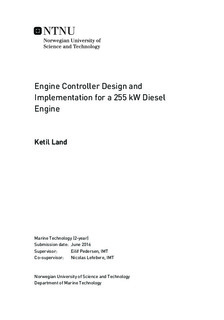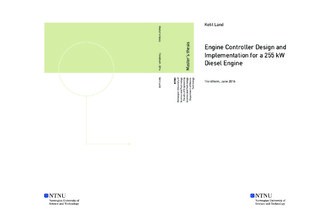| dc.description.abstract | A Hybrid Power Lab is established at the Marine Technology Centre by MARINTEK, ABB and NTNU. This is a DC-grid system where variable speed generators are essential to reduce fuel consumption and emissions. The traditional constant speed controller does not have the flexibility to use the full potential of this system. Therefore it would be interesting to create a platform for testing different controller concepts in the Hybrid Power Lab. In this thesis such a control platform is designed and implemented for a 255kW Perkins diesel engine in the Hybrid Power Lab. The engine offers a flexible platform for testing different controller concepts with its hydraulic/electrical controlled fuel system. The main objective is to develop an engine controller for the Perkins engine and test it on the engine with variable speed and zero generator load. Method used for creating the controller is a review of diesel engine performance parameters and diesel engine control. In addition a reverse-engineering method is used to collect data from the original engine controller at different speed and load levels. The behavior of the original controller is then mirrored into the developed controller for testing on the Perkins engine. The collected data include all the parameters important to engine speed control: engine speed and angular position of crankshaft, injector control oil pressure, injector current, start of injection and injection duration. The developed engine controller algorithms calculate the crankshaft speed and angular position to determine at what point fuel shall be admitted into the cylinders. The algorithms also control fuel injection pressure, injector current by a pulse width modulated signal, start of injection and injection duration. Test runs for the engine have been done with the new controller. In running mode the engine speed is automatically controlled by the controller at a desired setpoint. The test confirms that the developed controller is able to control the engine speed by changing the amount of fuel injected into the cylinders. A too late injection resulted in white smoke from the exhaust and by starting the injection earlier the white smoke disappeared. Recommendations for further work are listed at the end of the document. One item that will be mentioned here is the engine coolant temperature, which has a large influence on the controlled parameters and should therefore be studied further to improve the control algorithms. | |

